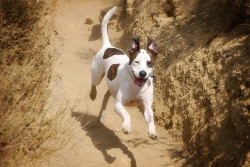A popular question posed frequently to trainers is “What do I do when Rover does x?”
But what if the question were phrased differently, as in: “What can I do to prevent x from happening?” By shifting the
paradigm of how to deal with problem behavior, there is a change from being reactive to proactive.
“What do I do when my dog jumps on the counter?”
How about what a pet owner can do to prevent their dog from jumping up on the counter by making sure there is nothing the dog can grab that reinforces the behavior while setting the dog up to learn that when it is close to the counter, it is more rewarding to remain on the ground than surfing the granite?
“What do I do when my dog urinates in the house?”
How about what can a pet owner do to prevent accidents in the house by taking their out to the appropriate spot frequently, praising and rewarding the pet for going in the “right” place?
Humans are naturally reactive. Some procrastinate. Some wait to correct problems rather than look at preventative measures.
The good thing about being proactive in dog training is that it almost forces a dog owner to only use positive-based methods, as dogs learn what to do by what is motivationally, more rewarding.

